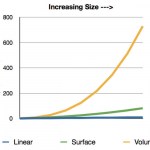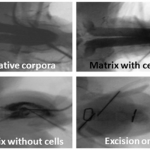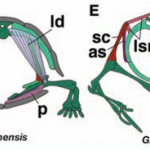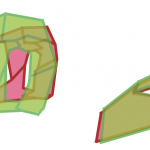development
My students are also blogging here:
My undergrad encounters
Developmental Biology
Miles' Devo Blog
Tavis Grorud’s Blog for Developmental Biology
Thang’s Blog
Heidi’s blog for Developmental Biology
Chelsae blog
Stacy’s Strange World of Developmental Biology
Thoughts of Developmental Biology
Today was more context and a bit of a caution for my developmental biology course. I warned them that we'd be primarily talking about animals and plants (and mostly animals at that), but that actually, all of the general processes we're describing are found in bacteria and other single…
Have you ever noticed how the religious regard 'scientism' and 'reductionism' and demands for concrete evidence as barely a notch above obscenities? That is, until they need to reduce complex issues to simplistic claims and don the mantle of Science to support their beliefs. Then they become Holy Writ.
You can really see this behavior in the abortion debate, where suddenly anti-choicers decide that humanity is defined by a particular arrangement of alleles in the genome. Case closed, they say, Science has spoken! Unfortunately, they get the science wrong, and we know their commitment to the…
I was bad. I didn't post my summary last week, so this is actually what I taught a week ago and what I taught today.
Previously, I'd given an overview of the foundations of modern developmental biology in embryology and anatomy. I gave them more history last week, only not so ancient: what led to the modern focus on patterns of gene expression? In the early 20th century, it was all Entwicklungsmechanick, the experimental manipulation of embryos and analysis of morphology in order to infer mechanisms of transformation (that's a bit of an oversimplification: we were also interested in…
Allen's Rule. One of those things you learn in graduate school along with Bergmann's Rule and Cope's Rule. It is all about body size. Cope's Rule ... which is a rule of thumb and not an absolute ... says that over time the species in a given lineage tend to be larger and larger. Bergmann's Rule says that mammals get larger in colder environments. Allen's Rule has mammals getting rounder in colder climates, by decreasing length of appendages such as limbs, tails and ears.
All three rules seem to be exemplified in human evolution. Modern humans tend to be larger and rounder in cooler…
I know it's early, but I expect it to be the best thing for a few days yet. David Byrne writes about his love affair with sound, and I came away from it feeling like I'd both learned something new and that it fit well with other ideas I already had — it was a revelation to see how well music and evolution fit together.
Because music evolves. Byrne's thesis is that it evolves to fit its environment (sound familiar?), and that you can see the history of a genre of a music in its sound. It's all about the spaces it was played in, which shapes the kind of sound can be used effectively…and he…
I am getting quite impressed with the progress being made in organ reconstruction. New techniques have allowed amazing improvements in bioengineering that allow whole complex organs to be grown in a dish and then surgically reimplanted — and much of this research is being driven by our military ventures, which provide a steady supply of scarred, damaged, and mutilated veterans who need new body parts. There I read that scientists are developing procedures to regrow penises…how could I not look up that paper? So I did, and now I have the current recipe for building new penises — or at least,…
In my post bashing that silly article claiming to have figured out how endoskeletons evolved from exoskeletons, there was a good question buried in the comments, and I thought I'd answer it.
Are there any models pulled out of arses which explain the turtle's unique skeleton?
Yes! I mean, no, not pulled out of arses, but there is a lot of really good and persuasive research that uses evidence to show how the turtle skeleton evolved.
First, I can see how this question popped up in a discussion of the evolution of endo/exoskeletons: the turtle shell is an excellent example of an exoskeleton…
I'm always telling people you need to understand development to understand the evolution of form, because development is what evolution modifies to create change. For example, there are two processes most people have heard of. One is paedomorphosis, the retention of juvenile traits into adulthood — a small face and large cranium are features of young apes, for instance, and the adult human skull can be seen as a child-like feature. A complementary process is peramorphosis, where adult characters appear earlier in development, and then development continues along the morphogenetic trajectory…
Vertebrates are modified segmented worms; that is, their body plan is made up of sequentially repeated units, most apparent in skeletal structures like the vertebrae.
Arthropods are also modified segmented worms. Look at a larval fly, for instance, and you can see they are made up of rings stacked together.
So here's a simple and obvious question: can we infer that the last common ancestor of vertebrates and arthropods was also a segmented worm? That is, is segmentation a common ancestral trait, or did arthropods and vertebrates invent it independently? At first thought, you might assume they…
A while back, I told you all about this small piece of the biochemistry of the fly eye — the pathways that make the brown and red pigments that color the eye.
I left it with a question: if even my abbreviated summary revealed considerable complexity, how could this pathway evolve? Changing anything produces a failure or change in the result. Before I answer, let's make the problem even harder, because I love a challenge (although actually, I'm cheating — it's going to turn out that complexity is not a barrier, but an opportunity).
The pigment pathways above are far downstream: they operate…
I was going to talk about a cool recent paper that described the evolution of novelties by way of modifying modular gene networks, but I started scribbling it up and realized that I was constantly backtracking to explain some fundamental concepts, so I stopped. I was concerned because one of the most common sources of confusion I've found in my students in the past was difficulty in distinguishing phenotypes from the complexities of the underlying genotype, and I have to be slow and thorough in setting up those differences early on until it sinks in, a habit I'm continuing here. It's so easy…
Last week, I gave a talk at UNLV titled "A counter-revolutionary history of evo devo", and I'm afraid I was a little bit heretical. I criticized my favorite discipline. I felt guilty the whole time, but I think it's a good idea to occasionally step back and think about where we're going and where we should be going. It's also part of some rethinking I've been doing lately about a more appropriate kind of research I could be doing at my institution, and what I want to be doing in the next ten years. And yes, I want to be doing evo devo, so even though I'm bringing up what I see as shortcomings…
I've been guilty of teaching bean-bag genetics this semester. Bean-bag genetics treats individuals as a bag of irrelevant shape containing a collection of alleles (the "beans") that are sorted and disseminated by the rules of Mendel, and at its worst, assigns one trait to one allele; it's highly unrealistic. In my defense, it was necessary — first-year students struggle enough with the basic logic of elementary transmission genetics without adding great complications — and of course, in some contexts, such as population genetics, it is a useful simplification. It's just anathema to anyone…
This video by Alexander Tsiaras is simultaneously lovely and infuriating; it's a product of technology and science, and the narration is profoundly anti-science.
There are some technical issues that annoy me about the video — it's a mix of real imagery and computer animation, and it doesn't draw a line between what is observed and what is fabricated — but it's visually stunning and otherwise fairly accurate.
But Tsiaras's running commentary…it's mystical airy-fairy glop. It takes awe and turns it into a celebration of ignorance.
Even though I am a mathematician, I look at this with marvel…
That's what he titles his latest youtube video, anyway. I laughed, just like I laughed when Eric Hovind called to complain about the misinformation on my website. He also claims I "accept defeat"
Myers accepts defeat see below:
Myers changes his stance from Ireland, In Ireland Myers says the 'Quran is Wrong'. After reviewing the iERA Research Paper he now believes its the Quran has ' very little opportunity for disproof, and they can be made to fit just about any reasonable observation.'
I am surprised to learn that I accepted defeat. Doesn't he know I'm indomitable? Anyway, here's the…
I have read the entirety of Hamza Andreas Tzortzis' paper, Embryology in the Qur'an: A scientific-linguistic analysis of chapter 23: With responses to historical, scientific & popular contentions, all 58 pages of it (although, admittedly, it does use very large print). It is quite possibly the most overwrought, absurdly contrived, pretentious expansion of feeble post hoc rationalizations I've ever read. As an exercise in agonizing data fitting, it's a masterpiece.
Here, let me give you the short version…and I do mean short. This is a paper that focuses with obsessive detail on all of two…
Kitties experience pain and suffering, which turns out to be a theological problem. If a god introduced pain and death into the world because wicked ol' Eve was disobedient, why is god punishing innocent animals? It seems like a bit of a rotten move to afflict the obedient along with the disobedient — shouldn't god have just stricken humanity with the wages of sin (or better yet, just womankind)?
William Lane Craig has an answer. His answer involves simply waving the problem away — animals don't really feel pain — and he drags in science to prop up his claim. Basically, Craig is playing the…
This is an article about cephalopods and eye evolution, but I have to confess at the beginning that the paper it describes isn't all that interesting. I don't want you to have excessive expectations! I wanted to say a few words about it, though, because it addresses a basic question I get all the time, and while I was at it, I thought I'd mention a few results that set the stage for future studies.
I'm often asked to resolve some confusion: the scientific literature claims that eyes evolved multiple times, but I keep saying that eyes show evidence of common origin. Who is right? Why are you…
Five articles (plus some photos from the recent Researchers' Night activities) are now online in the fall issue of Interface magazine (the Weizmann Institute's "friendly" science magazine).
â¢Read about a new kind of water treatment system - one that breaks down such complex, man-made chemicals in water as cleaning fluids, flame retardants and pesticide residues, turning them into simpler compounds that can then degrade naturally into harmless substances. Today, there is little that can be done about these pollutants, which are considered dangerous even in tiny amounts when they get into the…
It's a conference, in Oregon, and it's about The Future of Evo-Devo, all wonderful things, and it's on 10-12 February — right in the thick of the traditional Darwin Day hoopla, the days when I'm like a big egg-laying bunny at Easter. I'm already booked for Pullman, Washington, then Florida, then Las Vegas in that week.
You'll just have to go in my place and report back. Yes, you — the one looking around quizzically and wondering "why me?" Because I said so. Book it now. Portland, 10 February, the Nines Hotel.
Coincidentally, I'm giving a talk at UNLV that is kind of about the future of evo-…




